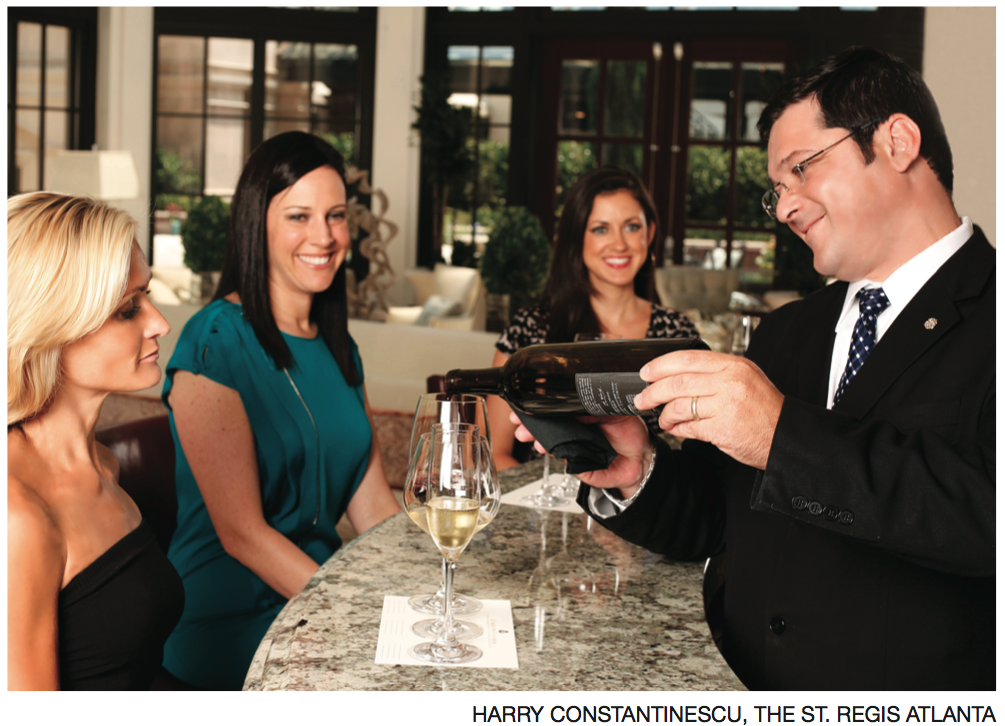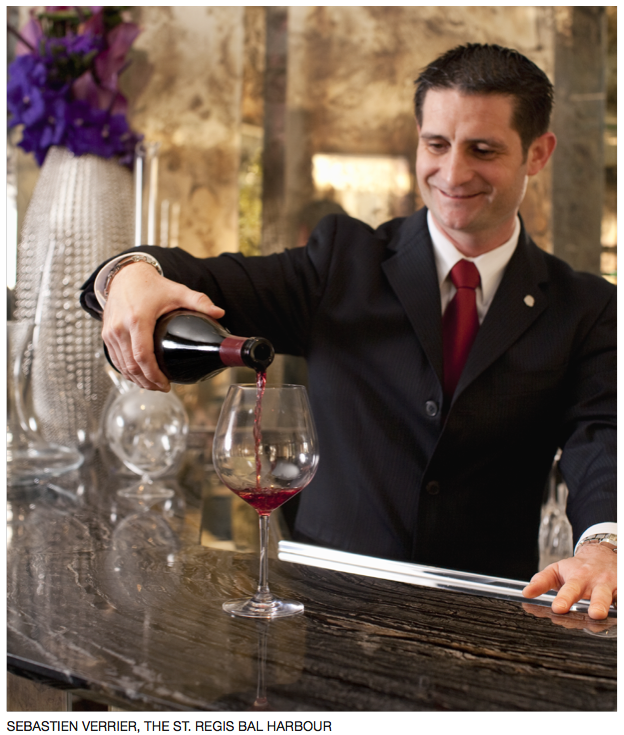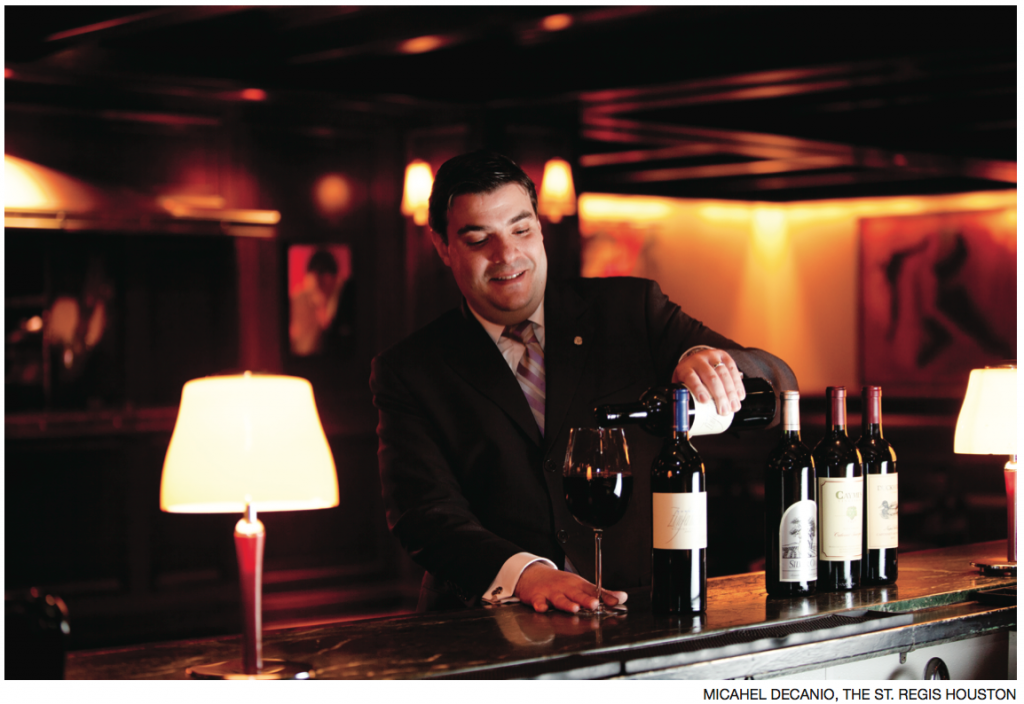Secrets of the Sommeliers
St. Regis expert sommeliers share their thoughts on the world’s best wines.
By Michelle Franzen Martin
Certified sommeliers are the world’s wine experts—trained in all aspects of wine, from grape varietals to storage, service and pairings. Each St. Regis Hotel & Resort employs expert sommeliers to maintain one-of-a-kind wine lists and recommend superior wines and pairings to guests. Here, we speak with six of these experts in-depth to discover their personal favorites, recommendations for surprising varietals and their best suggestions for mouth-watering pairings.
From Their Personal Cellars
Ask any sommelier to name his or her favorite wine, and you’ll get some creative answers.
“If I were the last person in the world and had to choose one single item that best would represent the pinnacle of human creation, then that item would be Krug Rosé Champagne,” says Harry Constantinescu, sommelier and wine director at The St. Regis Atlanta.
The Champagne has a gentle rustic overtone, with strawberry and overripe cherries accompanied by dried grass.
“It’s crisp, but not overwhelmingly acidic, with a long finish,” Constantinescu says.
Jura de Almeida, sommelier at The St. Regis New York, also considers Champagne among his personal favorites.
“I don’t have one favorite, but if stranded on a desert island, some Champagne and burgundy would get me through,” he says.
For Champagne, de Almeida prefers a Krug vintage brut from 1988 or Dom Perignon Oenotheque 1975.
“Both Champagnes are perfectly balanced with subtle notes of brioche and a texture that has fitness and power at the same time,” he says.
Like de Almeida, Daniel Grajewski can’t narrow down one favorite wine.
“I love them all equally,” says the diplomatic Grajewski, sommelier at The St. Regis Monarch Beach’s Stonehill Tavern. “I just like certain ones better on certain days. But if you forced me to choose, I would have to say that I love riesling the most for whites and pinot noir the most for reds.”
That’s because neither grape can be grown just anywhere, but are specific to their terroir.
“What I love about them most is that the grapes will always tell you where they are from without losing their identity,” he says. “Riesling from Alsace, France, and riesling from Mosel, Germany, are two different animals, but at the same time, they have a truth of riesling that runs through them. Pinot noir is the same way.”
But for Sebastien Verrier, sommelier for The St. Regis Bal Harbour, picking a favorite wine—or at least the varietal—is easy.
“I can name a few burgundys,” he says. “The best white burgundy all around is Montrachet. Just smelling it gives me goose bumps. It just makes you salivate because of the minerality of the wine. I could just stay and smell the wine over and over.”
Never Pass Judgment
 Michael DeCanio, sommelier and food and beverage director at The St. Regis Houston, says his favorite wine is the Ottimino Zinfandel—a Russian River wine from California that often is overlooked by serious wine drinkers.“My wife and I are both red zinfandel drinkers and first discovered this wine while dining in New York,” he says. “As soon as we tasted it, we knew that we had found our favorite wine.”Still, he acknowledges, zinfandel isn’t very popular with many wine enthusiasts.
Michael DeCanio, sommelier and food and beverage director at The St. Regis Houston, says his favorite wine is the Ottimino Zinfandel—a Russian River wine from California that often is overlooked by serious wine drinkers.“My wife and I are both red zinfandel drinkers and first discovered this wine while dining in New York,” he says. “As soon as we tasted it, we knew that we had found our favorite wine.”Still, he acknowledges, zinfandel isn’t very popular with many wine enthusiasts.
“I think red zinfandel in general may not get the respect it deserves,” he says. “But it is a very food- friendly wine that has great fruit.”
What are some other wines that are misjudged? John Vuong, sommelier at The St. Regis San Francisco, says sauvignon blanc is a good wine that shouldn’t be ignored.
“Sauvignon blanc seems to have become the stepchild of wine,” Vuong says. “It’s become ‘not cool’ to order sauvignon blanc, but it shouldn’t be. The wine has a really good structure and is very versatile.”
Vuong has been enjoying Italian sauvignon blanc, as well as others from Napa Valley that are aged in concrete. The concrete gives the wine a different feel, he says.
Grajewski says he’s surprised by the public’s perception of Australian wines—one wine myth that he’d like to debunk.
“Right now I’m on a big kick with Australian wines after spending two weeks there recently,” he says. “What was most surprising was the perception of what Australian wines are in the United States: the perception they only make big, rich, over- extracted, high-alcohol wines that are made only for the big scores from reviewers.
“But what surprised me is that the wines we tried from multiple regions in Australia were just the opposite. I had wines that were soft and elegant, with low alcohols and high acidity, from regions that are colder than we think Australia is.”
Grajewski recommends trying wines from a variety of Australian regions, such as Yarra Valley, Mornington Peninsula and Clare Valley.
“Wine is about balance, and these regions are the epitome of balance,” he says.
The more mainstream merlot is Constantinescu’s pick for a wine that often is passed over, but that deserves recognition.
“Merlot has been looked down on and has lost a lot of popularity in the past decade due to some movies, reviews or simply because it was considered old news,” he says. “But let’s not forget that merlot is the main blending partner of cabernet sauvignon in Bordeaux and the main ingredient of one of the most expensive wines in the world: Petrus (a Bordeaux wine estate).” So yes, don’t sleep on merlot, or else it’s your loss.
Versatility
The St. Regis sommeliers have different opinions on what is the most versatile wine.
“I really like working with pinot noir since you can use it for many different pairings,” DeCanio says. “The versatility of the grape is great since you can find lighter-bodied pinots that work very well with fish and some really nice full-bodied pinot noirs that work great with grilled meats. It also is a great wine to enjoy on its own.”
 Constantinescu agrees, adding that the grape’s difficulty to grow only makes it more special.
Constantinescu agrees, adding that the grape’s difficulty to grow only makes it more special.
“Probably most winemakers will agree with this,” he says. “Besides the fact that it is a difficult grape to grow, it is influenced by every single component of the terroir and is prone to mutation with hundreds of clones grown in different vineyards. However, when handled properly, it can produce some of the deepest and most complex wines in the world.”
But other St. Regis sommeliers say the most versatile wines are among the white variety.
For de Almeida, the most versatile wine is Champagne—which goes well as an aperitif, or with food and dessert, he says.
Another versatile white wine: riesling. Both Grajewski and Vuong like its versatility. Reisling is high in acid, which is key in food pairings, Vuong explains.
“It’s a good palate cleanser,” he explains, adding that he likes the traditional German tradition of pairing riesling with pork.
Grajewski agrees: “Riesling can come in all shapes and sizes—from bone dry to sticky sweet, still to sparkling—but it always has a great backbone of acidity that is refreshing.”
Verrier also prefers another white wine for versatility—chenin blanc.
“Vouvray (from the Loire Valley in France) has a little bit of sugar, but an also a mushroom character because of the soil and microclimate,” he explains.
“It is one of the most unique sweet wines in the world, and I like to pair it with foie gras terrine with slices of fresh black truffle.”
Perfect Pairings
DeCanio, too, likes to pair wine with foie gras, but his choice would be Sauternes—a sweet white wine from France blended with semillon, sauvignon and muscadelle grapes.
“This may be on the decadent side, but I really love foie gras and a nice Sauternes,” he says. “If Sauternes is out of your budget, a late-harvest riesling or moscato would be a great substitute.”
Grajewski, who also likes foie gras and Sauternes, also prefers regional pairings.
“When eating food of the region, it only makes sense to drink the wines of that region,” he says. “I like to pair Bordelaise lamb with a (red) wine from Pomerol, France. It’s just heavenly.”
Constantinescu’s perfect pairing is seared scallops and white meursault, whose dominant grape variety is chardonnay.
“I often think about meursault as being scallops in liquid form,” he says.
And de Almeida’s favorite pairing involves a French red wine: Chateauneuf du Pape, from the Cotes du Rhone region. It’s best enjoyed with duck, he says.
“It is earthy and powerful with black and red fruit flavors,” de Almeida coments.
Some Must-Trys
When it comes to suggesting great wines, the St. Regis sommeliers offer a plethora of choices.
“What I would love is for everyone to try a wine they never have had, whether it’s a grape not many people have ever heard of like assyrtiko from Greece or even a more famous grape like merlot, only from a region they’ve never had it from before,” Grajewski says. “I wouldn’t even hope for everyone to like what they tried, but what I would hope for is for people to have opened their eyes to something new.”
For DeCanio, that wine is Albariño.“It is a great wine from Spain that is a bit on the lighter side but very food-friendly and refreshing,” he says. “One that stands out and is easily accessible is the Martin Codax.”
The Martin Codax Albariño, from the Rias Baixas region, is a crisp and dry white wine with flavors of pear, passion fruit and apple.
Constantinescu, who is as much intrigued by the stories behind the wine as he is with the taste, says the Commandaria is a must-try.
The amber-colored sweet dessert wine, made from xynisteri and mavro grape varieties, comes from the Commandaria region of Cyprus. It’s also the oldest named wine in production, with the name dating back to the crusades in the 12th century. The wine also is the first to be named by the place of origin and not the grape varietal, Constantinescu says.
“Many people are now familiar with the stories surrounding the Knights Templar (a Western Christian military order that existed during the Middle Ages), but do they know they also produced an amazing wine that they carried around the world during their crusades for the kings to drink?” Constantinescu says.
One more great sweet wine to try: Tokaji, from the Tokaj-Hegyalja region in Hungary, de Almeida says.
“It’s grown in the Carpathian Mountains at a high altitude,” he says. “It formerly was the sweet wine of choice for royalty, and in its most rarified form—Eszencia—it is among the best sweet wines in the world.”
At The St. Regis
Every wine list is different, and at the St. Regis, sommeliers showcase their years of expertise while creating a wine list that reflects a variety of regions, price points and some personal preferences.
DeCanio, who favors red zinfandel, includes Seghesio Sonoma Zinfandel on the wine list. It is available by the glass or by the bottle at The St. Regis Houston.
“It is the red that I believe everyone must try when they join us at the St. Regis,” he says. “It’s the quintessential zinfandel that has great fruit and nice body. The Seghesio family has been making award- winning zinfandels for a very long time, and they’re often listed on the top 100 wine list each year by ‘Wine Spectator.’ ”
Verrier recommends that guests try Albarino Nessa, from Spain’s Rias Baixas region. Available by the glass at The St. Regis Bal Harbour, the wine has a crisp, bright flavor of apples and pears. “It’s a very aromatic, refreshing wine,” he explains.
When visiting The St. Regis New York, be sure to try Domaine Ramonet’s Chassagne Montrachet 1er Cru Clos de la Boudriotte 2008. De Almeida describes it as ethereal and light-bodied. It’s available both by the glass and by the bottle.
Constantinescu brings his passion for wine and history to The St. Regis Atlanta, where he includes Stag’s Leap Hands of Time meritage among the wine offerings. It is available by the glass and by the bottle.
“What makes this particular winery special is that we owe the success of the American wine industry, in part, to them,” he says.
That’s because in 1976, the Napa Valley-based winery won in a famous blind tasting in Paris over the First Growths of Bordeaux (arguably the best terroir in the region).
“The wine is a tribute to all of the winemakers who have worked for Stag’s Leap over the years,” Constantinescu says of the meritage.
When visiting The St. Regis San Francisco, Vuong recommends trying the Chateau Musar red wine from Lebanon.
“There is a lot of history in the winery, and the area is war-torn, of course, but in their struggles, they’ve achieved a delicious wine,” Vuong explains. “It’s very Old World and different. When people talk about Lebanese wines, they always think of Chateau Musar.”
Whichever St. Regis you visit, a one-of-a-kind wine experience curated by experts is guaranteed.









